Related Research Articles

The Dytiscidae – based on the Greek dytikos (δυτικός), "able to dive" – are the predaceous diving beetles, a family of water beetles. They occur in virtually any freshwater habitat around the world, but a few species live among leaf litter. The adults of most are between 1 and 2.5 cm (0.4–1.0 in) long, though much variation is seen between species. The European Dytiscus latissimus and Brazilian Megadytes ducalis are the largest, reaching up to 4.5 cm (1.8 in) and 4.75 cm (1.9 in) respectively. In contrast, the smallest is likely the Australian Limbodessus atypicali of subterranean waters, which only is about 0.9 mm (0.035 in) long. Most are dark brown, blackish, or dark olive in color with golden highlights in some subfamilies. The larvae are commonly known as water tigers due to their voracious appetite. They have short, but sharp mandibles and immediately upon biting, they deliver digestive enzymes into prey to suck their liquefied remains. The family includes more than 4,000 described species in numerous genera.
Carabdytes alutaceus is an endangered species of beetle in the family Dytiscidae. It is endemic to New Caledonia, in the southwest Pacific Ocean.
Meridiorhantus orbignyi is an extinct species of predaceous diving beetle in the family Dytiscidae. This species was formerly a member of the genus Rhantus.
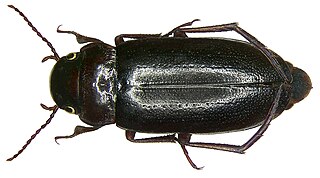
Carabdytes is a genus of predaceous diving beetles in the family Dytiscidae. Carabdytes upin was formerly the sole species of this genus, but nine species in the genus Rhantus were transferred to Carabdytes as a result of research published by Balke et al. in 2017.
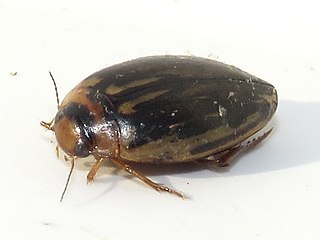
Coptotomus is a genus of predaceous diving beetles in the family Dytiscidae, the only genus of the subfamily Coptotominae. There are about six described species in Coptotomus, found in North America and the Neotropics.
Nirripirti is a genus of beetles in the family Dytiscidae. However the Australian Faunal Directory considers it a synonym of the genus, Paroster, on the basis of work by Leys and Watts, and Toussaint, Hendrich and others.

Helochares is a genus of water scavenger beetles in the family Hydrophilidae, represented by 161 described species. It is distributed across the Afrotropical, Australasian, Indo-Malayan, Nearctic, and Palearctic realms.
Carabdytes plantaris is a naturally uncommon species of diving beetle in the family Dytiscidae. It is endemic to New Zealand. For over a century, it was known from just a single specimen collected in 1880 "near Dunedin", and doubts were cast on whether it was actually a New Zealand species at all. In 1986, it was rediscovered when several were collected from a roadside pond near Lake Ellesmere. Carabdytes plantaris is now classed as "naturally uncommon" by the Department of Conservation.

Nartus grapii is a species of beetle in family Dytiscidae, found in the Palearctic. This species was formerly a member of the genus Rhantus.
Nartus sinuatus Black with dark rufous legs; posterior margin of pronotum arched just before hind angles(3) is a species of predaceous diving beetle in the family Dytiscidae, found in North America. This species was formerly a member of the genus Rhantus.

Neobidessodes is a genus of predaceous diving beetles in the family Dytiscidae. There are about 10 described species in Neobidessodes. They are found in Australasia. The genus was first described in 2009, and the type species is N. denticulatus.
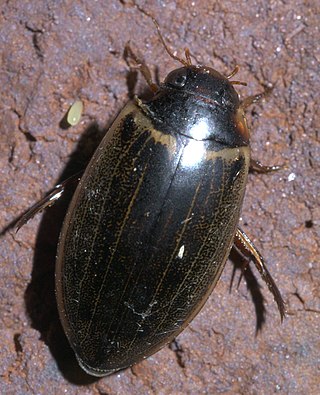
Meridiorhantus is a genus of predaceous diving beetles in the family Dytiscidae. There are about five described species in Meridiorhantus, found in the Neotropics and North America. These species were formerly members of the genus Rhantus, but were moved to Meridiorhantus when it was created by Balke et al. in 2017.
Caperhantus is a genus of predaceous diving beetles in the family Dytiscidae. There is one described species in Caperhantus, C. cicurius. This species was formerly a member of the genus Rhantus.

Nartus is a genus of predaceous diving beetles in the family Dytiscidae. There are at least two described species in Nartus. These species were formerly members of the genus Rhantus, but were moved to Nartus when it was reinstated by Balke et al. in 2017.
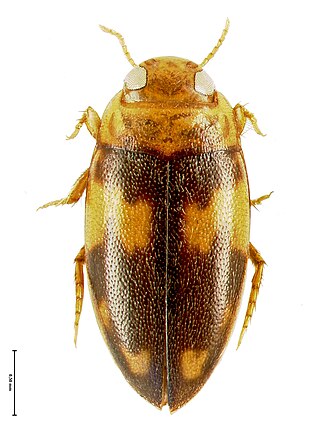
Neobidessodes flavosignatus is a carnivorous subterranean water beetle, in the Bidessini tribe of the Dytiscidae family. It was first described in 1922 by Albrecht Zimmermann as Bidessus flavosignatus. It was assigned to the genus Bidessodes by Watts in 1978, and to the new genus of Neobidessodes in 2009 by Hendrich and others.
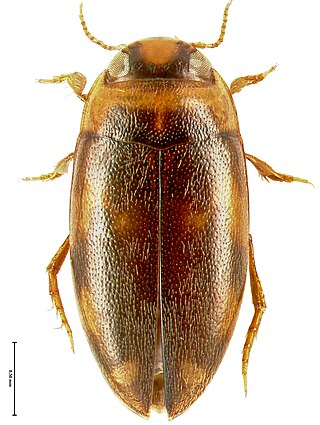
Neobidessodes mjobergi is a carnivorous subterranean water beetle, in the Bidessini tribe of the Dytiscidae family. It was first described in 1922 by Albrecht Zimmermann as Bidessus mjobergi, and reassigned to the genus of Neobidessodes in 2009 by Hendrich and others.
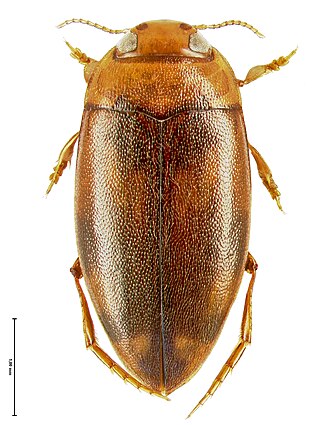
Neobidessodes grossus is a carnivorous subterranean water beetle, in the Bidessini tribe of the Dytiscidae family. It was first described in 1922 by Albrecht Zimmermann as Bidessus grossus. It was assigned to the genus Bidessodes by Watts in 1978, and to the new genus of Neobidessodes in 2009 by Hendrich and others.
Neobidessodes bilita is a carnivorous subterranean water beetle, in the Bidessini tribe of the Dytiscidae family. It was first described in 1978 by Chris H.S. Watts as Bidessodes bilita, and reassigned to the genus of Neobidessodes in 2009 by Hendrich and others.
Paroster caecus is blind beetle in the Hydroporini tribe of the subfamily Hydroporinae in the Dytiscidae family. It was first described by Chris Watts in 1982 as Terradessus caecus. It was transferred to the genus, Paroster, in 2016 by Toussaint, Hendrich and others.
Batrachomatus nannup is a species of diving beetle in the family, Dytiscidae, first described as Allomatus nannup in 1978 by Chris H.S. Watts. The holotype was collected in Bridgetown, Western Australia. In a generic revision in 2013, Lars Hendrich and Michael Balke synonymised AllomatusMouchamps, 1964 with Batrachomatus Clark, 1863, thus changing the species name.
References
- ↑ Tessa M. Bradford; Rafał Ruta; Steven J. B. Cooper; María L. Libonatti; Chris H. S. Watts (4 May 2022). "Evolutionary history of the Australasian Scirtinae (Scirtidae; Coleoptera) inferred from ultraconserved elements". Invertebrate Systematics. 36 (4): 291–305. doi:10.1071/IS21053. ISSN 1445-5226. Wikidata Q120259766.
- ↑ C.H.S. Watts (1964). "The larvae of Australian Cybister spp. Curt., Homoeodytes spp. Reg. and Hyderodes shuckardi Hope (Coleoptera: Dytiscidae)". Transactions of the Royal Society of South Australia. 88: 145–156. ISSN 0372-1426. Wikidata Q111569523.
- ↑ Lars Hendrich; Michael Balke; Chris H. S. Watts (9 November 2016). "Description of a new Tiporus Watts, 1985 from northern Queensland, Australia (Coleoptera: Dytiscidae, Hydroporinae)". Zootaxa . 4189 (1): 174–182. doi:10.11646/ZOOTAXA.4189.1.10. ISSN 1175-5334. PMID 27988764. Wikidata Q28940105.
- ↑ Lars Hendrich; Chris H S Watts; Michael Balke (12 October 2020). "The "minute diving beetles" of southern Australia - taxonomic revision of Gibbidessus Watts, 1978, with description of six new species (Coleoptera, Dytiscidae, Bidessini)". ZooKeys . 975: 11–49. doi: 10.3897/ZOOKEYS.975.55456 . ISSN 1313-2989. PMC 7572521 . PMID 33117063. Wikidata Q101052986.